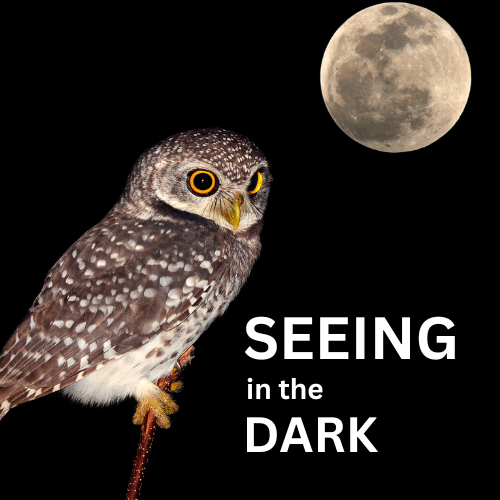Night Vision


Night vision, or the ability to see in the dark, is possible by the eye’s ability to fine tune a balance of light, absorption and processing.
Humans cannot see in total darkness. But usually there is some available light that will allow us to see and what is commonly called “night vision” is the ability to see in these low-light conditions.
The three main eye features that allow night vision are the pupil, the eye’s light-sensing cells in the retina, and photopigments.
The pupil
The pupil is the black circular opening in the center of the iris, which is the colored part of the eye. The pupil looks black because the light that enters it is absorbed by the structures inside the eye.
The main function of the pupil is to regulate the amount of light that enters the eye. When we are exposed to bright light, such as sunlight or a flashlight, the muscles in the iris contract, causing the pupil to constrict and become smaller. This helps to limit the amount of light that enters the eye and prevents the retina from being overwhelmed by the bright light.
Conversely, in low-light conditions, the muscles in the iris relax, causing the pupil to dilate and become larger. This allows more light to enter the eye, which improves our ability to see in low-light conditions.
The light-sensing cells in the retina
The light-sensing cells in the retina of the eye are called photoreceptor cells. There are two types of photoreceptor cells in the retina: rods and cones.
Rods are more numerous than cones and are responsible for detecting light in low-light conditions, such as at night. They are more sensitive to light but do not distinguish between different colors.
Cones, on the other hand, are responsible for color vision and are most active in bright light.
Photopigments
Both rods and cones contain light-sensitive pigments called photopigments, which undergo chemical reactions when they absorb light and then trigger electrical signals that are sent to the brain via the optic nerve.
Rhodopsin is a light-sensitive protein found in the rod cells of the retina of the eye. It plays a crucial role in the process of vision by helping to detect and convert light into electrical signals that can be transmitted to the brain.
Rhodopsin consists of two parts: a protein called opsin and a light-sensitive molecule called retinal. Both opsin and the light-sensitive molecule retinal are derivatives of vitamin A.
When light enters the eye and strikes the light-sensing retinal molecule, it undergoes a chemical reaction that causes it to change shape. This change in shape triggers a series of electrical signals that are sent to the brain via the optic nerve, allowing us to see in low-light conditions.
Retinal is constantly being used and regenerated by the body because it is continually being exposed to light and undergoing chemical reactions.
How to prepare your eyes to see in low-light conditions
- Give your eyes time to adjust: When you first enter a dark environment, it can take several minutes for your eyes to fully adjust to the low light conditions. This is because your pupils need time to dilate and your rod cells need time to become more sensitive to light.
- Allow your eyes to rest: If you have been exposed to bright light for an extended period of time, such as from a computer screen or a phone, it can take longer for your eyes to adjust to low light conditions. Giving your eyes a rest for a few minutes before entering a dark environment can help them adjust more quickly.
- Avoid bright lights before entering a dark environment: Exposure to bright light can cause your pupils to constrict, which can make it more difficult for your eyes to adjust to low light conditions. Try to avoid bright lights or direct sunlight for a few minutes before entering a dark environment.
- Eat foods rich in Vitamin A: Vitamin A is important for maintaining the health of your eyes and improving night vision. Foods such as carrots, sweet potatoes, and spinach are good sources of Vitamin A.
- Use proper lighting: If you know you will be entering a low-light environment, use proper lighting to help your eyes adjust. This could mean using a small light source to gradually increase the light level in the room, or using a red-tinted light, which can help preserve your night vision by minimizing the effects of bright light on your eyes.
Gregory Scimeca, M.D.
Ophthalmologist and Medical Director
The Eye Professionals
Our Locations
